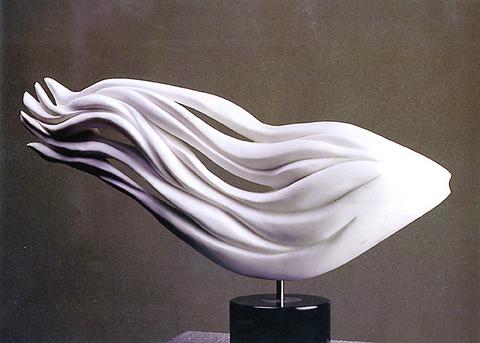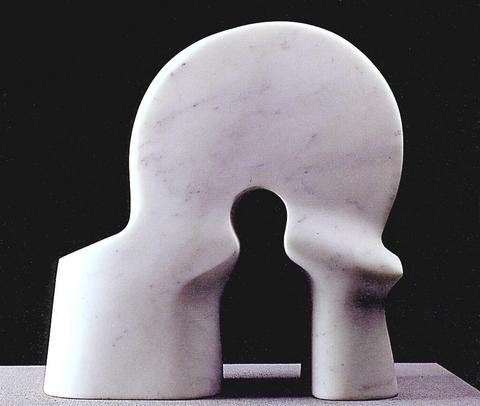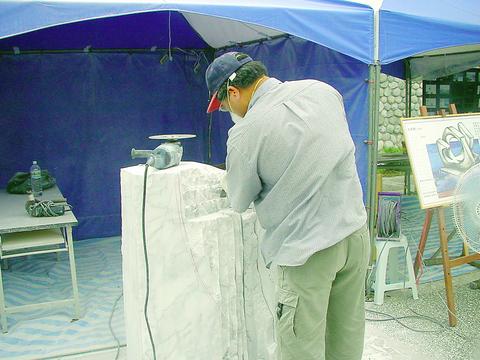Nicknamed the Land of Stone, Hualien County is known for being seated above the juncture of all-too-active tectonic plates. With 90 percent of the entire county dominated by mountains, its greatest claim to fame is marble and many other kinds of stone. This unique quality, compounded with its breath-taking scenic views, sharp-rising stone cliffs such as those found in fabulous Taroko Gorge offers one of the best natural environments for residents in Hualien in their vigorous production of stone artwork.
Hualien County has held an international stone sculpture festival biannually since 1997. This year's event differs in that the county's cultural bureau has focused on displaying the work of local talent. Shen Chung-yuan (沈中元), director of the cultural bureau, told the Taipei Times: "There will be 10 participating artists, either from Taiwan or other countries, taking part in the international festival next year. Most of their artworks will be around 2m high."
Last October, 12 stone sculpture artists from New Zealand, Italy, France, the Netherlands, Japan and Taiwan took residence in Hualien for a month to talk shop. Among them, only two were Taiwanese artists, but their outstanding performances received wide publicity both inside the country and abroad and made the County residents very proud.

PHOTO COURTESY HUALIEN CULTURE BUREAU
The Hualien Stone Sculpture Festival's Divine Sculpture Tour (
Huang Ming-hsien (
Other types of artistic carvings from materials like wood, leather, ice, jade, paper, eggshells and glass will be shown daily to visitors as well. One of the most striking aspects of the festival is that many Aboriginal artists are present to promote their own tribe's artistic achievements.

PHOTO COURTESY HUALIEN CULTURE BUREAU
The idea behind this year's activities is an attempt to further create a lively stone sculpture environment in Hualien based on the accomplishments of the past three international festivals. The county therefore channels a great deal of its effort into bringing together resources from local tourist industries and stone sculptors in the hopes of offering the public an in-depth view of the county's new look after it is decorated with the many stone masterpieces.
These art pieces spread from north to south along the County's major scenic routes and have become new local scenic landmarks. A map of the area's sculpture map of Hualien has since been produced and the county government is daring any visitor to see them all within a day.
Activities surrounding the "Divine Sculpture Tour" also emphasize visitors' participation, young and old alike. A rather large portion of the outdoor area is specifically designated for school-aged children to experience the fun of gravel stone carving and pottery making. A sequence of booths with volunteer workers is set up to test their knowledge of local stones and stone sculptures.

PHOTO COURTESY HUALIEN CULTURE BUREAU
Moreover, exhibits such as Taiwan's precious rose stones or rhodonite (
Starting from today, visitors to the Divine Sculpture Post Station (
Tchen Yu-Chiou (陳郁秀), chairwoman of the council for cultural affairs once commented: "Hualien was originally a major stone-working area of Taiwan. As a result of the strenuous efforts of stonework operators over many years and the local cultural milieu, Hualien has become a key center for stone sculpting." Over the years, the stone materials in Hualien have caused many small enterprises to become prosperous. When the Meilun Industrial Park (美崙工業區) was set up 20 years ago, the stone-cutting industry, working together with the handicraft community there, gradually gave birth to the stone sculpture enterprises of today.

PHOTO: DEREK LEE, TAIPEI TIMES
Right after the 2001 festival, applications for sculptor-in-residence have come from France, Italy, Japan, the US and other strongholds of the arts. With this trend, it is predicted that the county may likely become Asia's premier city for stone sculpture.
Inspired by G. Borglum's sculpture of four US presidents in the Black Hills of South Dakota and Egypt's giant sphinx sculpture, Hualien County is searching for a large-scale stone sculpture to be made ready by the year 2008 to serve as the county's central landmark. Shen Chung-yuan explained: "The stone sculpture will be 50m by 50m. It will most likely be situated in an abandoned mine area where the location can be re-utilized and turned into a cultural park of some sort. At this stage, we are still looking for suggestions as to what would be the subject sculpted."

PHOTO: DEREK LEE, TAIPEI TIMES

June 9 to June 15 A photo of two men riding trendy high-wheel Penny-Farthing bicycles past a Qing Dynasty gate aptly captures the essence of Taipei in 1897 — a newly colonized city on the cusp of great change. The Japanese began making significant modifications to the cityscape in 1899, tearing down Qing-era structures, widening boulevards and installing Western-style infrastructure and buildings. The photographer, Minosuke Imamura, only spent a year in Taiwan as a cartographer for the governor-general’s office, but he left behind a treasure trove of 130 images showing life at the onset of Japanese rule, spanning July 1897 to

One of the most important gripes that Taiwanese have about the Democratic Progressive Party (DPP) is that it has failed to deliver concretely on higher wages, housing prices and other bread-and-butter issues. The parallel complaint is that the DPP cares only about glamor issues, such as removing markers of Chinese Nationalist Party (KMT) colonialism by renaming them, or what the KMT codes as “de-Sinification.” Once again, as a critical election looms, the DPP is presenting evidence for that charge. The KMT was quick to jump on the recent proposal of the Ministry of the Interior (MOI) to rename roads that symbolize

On the evening of June 1, Control Yuan Secretary-General Lee Chun-yi (李俊俋) apologized and resigned in disgrace. His crime was instructing his driver to use a Control Yuan vehicle to transport his dog to a pet grooming salon. The Control Yuan is the government branch that investigates, audits and impeaches government officials for, among other things, misuse of government funds, so his misuse of a government vehicle was highly inappropriate. If this story were told to anyone living in the golden era of swaggering gangsters, flashy nouveau riche businessmen, and corrupt “black gold” politics of the 1980s and 1990s, they would have laughed.

In an interview posted online by United Daily News (UDN) on May 26, current Chinese Nationalist Party (KMT) Chairman Eric Chu (朱立倫) was asked about Taichung Mayor Lu Shiow-yen (盧秀燕) replacing him as party chair. Though not yet officially running, by the customs of Taiwan politics, Lu has been signalling she is both running for party chair and to be the party’s 2028 presidential candidate. She told an international media outlet that she was considering a run. She also gave a speech in Keelung on national priorities and foreign affairs. For details, see the May 23 edition of this column,